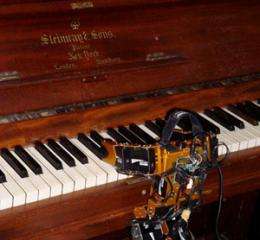Music-playing robot developed by Drexel students

Only a decade ago, musically-aware humanoids, or robots, equipped to play popular songs on the piano and dance to audio beats could have come to life only in a science fiction film, but for Drexel University graduate student Alyssa Batula developing a music-playing robot is very much a reality.
Batula and her collaborators led by Dr. Youngmoo Kim, assistant professor of electrical and computer engineering at Drexel and director of Drexel’s Music and Entertainment Technology Laboratory, are pursuing a long-term goal of enabling a humanoid to be an interactive participant in a live music ensemble with other performers.
“Through projects like these, we learn about human creativity and human expression,” said Kim. “These are extremely difficult to study and quantify but by teaching a robot to mimic creative performance, we also reveal insights about human capabilities and are better able to understand them.”
RoboNova, one of several humanoids used for research by two Drexel engineering labs—the Music and Entertainment Technology Laboratory (MET-lab) and the Drexel Autonomous Systems Laboratory (DASL)—is a miniature humanoid for rapid prototyping and testing. The RoboNova kit can be configured as a humanoid, so it can mimic some human gestures.
Kim and a team of researchers that included Batula enabled the RoboNova to perform a variety of tasks, such as to dance to live music and to play the piano. The team created videos of RoboNova playing “Chopsticks” and “Twinkle Twinkle Little Star,” as well as a dance number to a real-time audio beat track. RoboNova is also being studied for more than its entertainment value.
“From a research and psychological perspective if we can get a humanoid robot to play like a human performer, researchers could use it to study musicians’ gestures and see how these gestures affect the quality of the performance,” said Batula, an electrical engineering major.
RoboNova has provided researchers with the ability to review physical actions when it comes to a musical performance.
“It’s impossible for humans to repeat a performance exactly, and equally impossible for humans to make precisely pre-defined changes, but a robot can be programmed to do that,” said Kim. “In teaching the robot or exploring different variations, we learn more about how humans perform.
MET lab is devoted to research in digital media technologies that will shape the future of entertainment, especially in the areas of sound and music. MET-lab's research spans the following music and entertainment applications: music production and playback technology, machine listening and music information retrieval, and new music interfaces and robotics.
DASL, under the direction of Dr. Paul Oh of the mechanical engineering and mechanics department at Drexel, consists of students from the freshman level to doctoral candidates. The lab is a multidisciplinary environment with projects and students coming from electrical and computer engineering, mechanical engineering, computer science, and even psychology. Current projects range from unmanned aerial/ground vehicle applications to humanoid robotics.
Provided by Drexel University




















